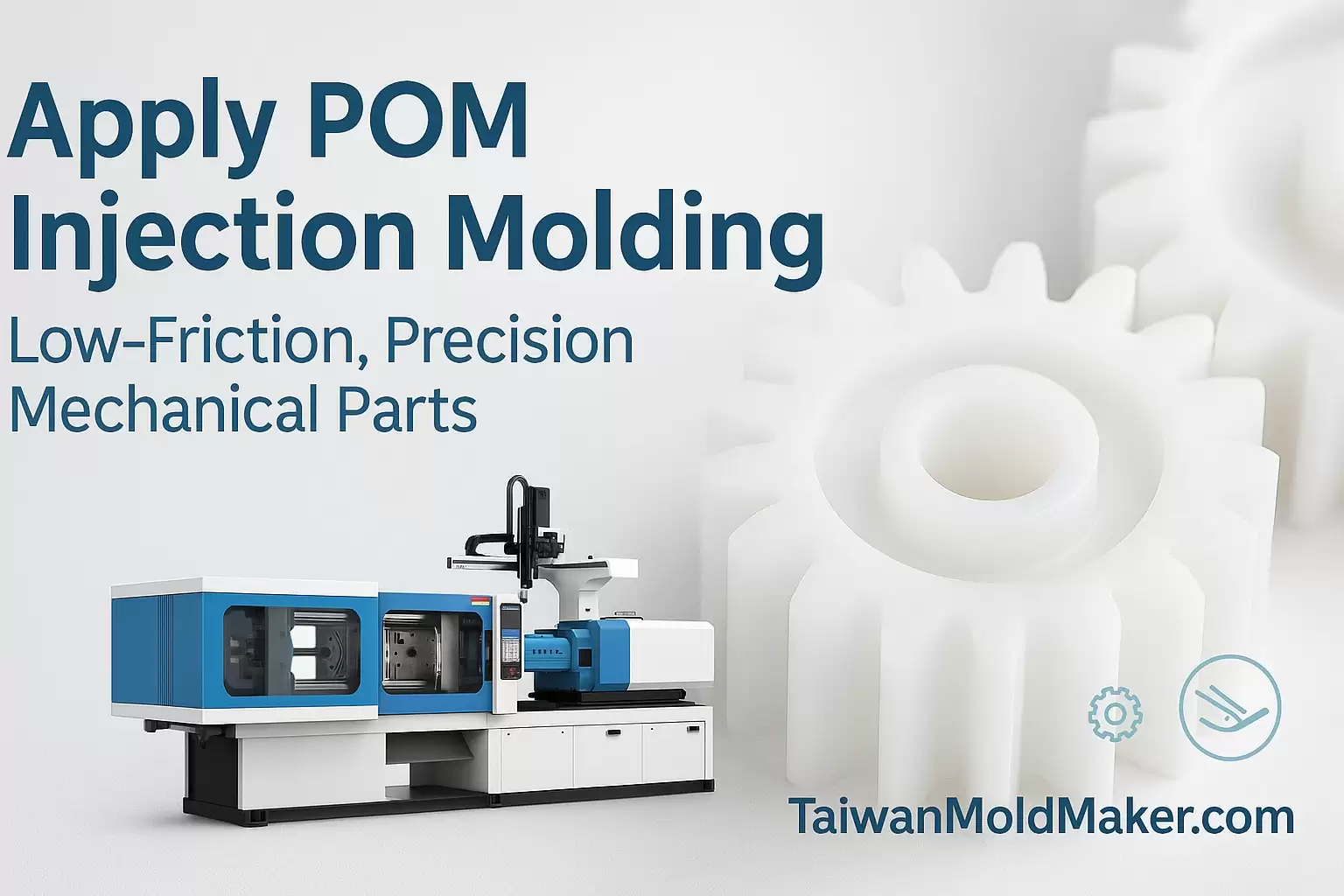Apply POM (Acetal) Injection Molding for Low-Friction, Precision Mechanical Parts
Apply POM (Acetal) Injection Molding for Low-Friction, Precision Mechanical Parts
Polyoxymethylene (POM)—also called acetal—is the go-to engineering thermoplastic for mechanisms that demand tight tolerances, dimensional stability, and very low friction. With the right tooling, gate strategy, and process window, POM delivers gear-grade precision at mass-production speed. Here’s a practical playbook—and how TaiwanMoldMaker.com gets you from DFM to validated parts fast.
1) Why Choose POM for Moving Mechanisms?
| Property | What It Means for Your Part |
|---|---|
| Low coefficient of friction | Smooth sliding and quiet running without external lube (ideal for gears, slides, latches) |
| High stiffness & fatigue resistance | Maintains tooth geometry and snap-fit forces over millions of cycles |
| Excellent creep & wear performance | Holds tolerances under load; long service life |
| Moisture/chemical resistance | Stable dimensions vs. humidity; resistant to fuels, oils, solvents |
| Thermal stability | Works from roughly −40 °C to +100 °C (higher with special grades) |
Common grades: unfilled, PTFE-lubricated (ultra-low friction), glass-fiber (stiffer), and UV/food-contact variants.
2) Copolymer vs. Homopolymer—Pick the Right POM
| Attribute | POM-C (Copolymer) | POM-H (Homopolymer) |
|---|---|---|
| Thermal stability | Better resistance to hot water/alkali; broader processing window | Slightly higher stiffness & hardness |
| Friction & wear | Excellent (very good with PTFE-filled grades) | Excellent (best dry wear in some applications) |
| Dimensional stability | Very good | Very good (can be slightly higher shrink) |
| Typical choice | General mechanisms, water-exposed parts | High-precision gears, cams, bushings |
3) Design Guidelines for Precision & Low Wear
-
Wall thickness: 0.8–3.0 mm typical (uniform walls reduce warp on crystalline POM).
-
Ribs & bosses: ribs at 0.6–0.8× wall; boss roots with generous fillets (≥ 0.5× wall).
-
Draft: 1–2° per side; more on textured surfaces.
-
Corners: use radii to minimize stress concentrators and avoid squeak.
-
Gates: sub-gates or valve-gated hot runners near heavy sections; for gears, gate on hub and balance flow to teeth.
-
Tolerances: ±0.05–0.10 mm is common on molded POM with a locked process window; tighter features may need post-machining or mold compensation.
-
Noise control: specify PTFE-modified POM for ultra-quiet gears/sliders; add micro-textures on contact faces to lower stick-slip.
4) Processing Window (Get First-Shot-Right)
| Parameter | Typical Starting Range | Purpose / Notes |
|---|---|---|
| Melt temperature | ~ 190–210 °C (grade-specific) | Avoid overheating; POM degrades if held hot too long |
| Mold temperature | 70–100 °C | Higher mold temps improve crystallinity & dimensional stability |
| Injection speed | Medium–high | Fill thin sections before freeze-off; prevent knit-line weakness |
| Pack/hold | 50–70 % of peak, short/controlled | Prevents sink & over-packing (warpage) |
| Venting | ~ 0.02 mm | Prevents burn/diesel marks on fast-filling features |
| Drying | Usually not required | Keep resin sealed and clean; purge before shutdown |
Safety & maintenance:
-
Do not contaminate with PVC—decomposition risk.
-
Limit residence time at temperature; purge at shutdown.
-
Use corrosion-resistant tool steels and proper ventilation (formaldehyde can evolve if overheated).
5) Applications That Win with POM
-
Gears, cams, racks, worm wheels (quiet, wear-resistant trains)
-
Slides, rails, linear bearings (self-lubricating)
-
Precision latches, hinges, snap-fits (fatigue resistant)
-
Pump/valve components, fuel-system parts (chemical/low-swelling)
-
Connector housings, bobbins, keyboard mechanisms (dimensional stability)
6) Case Snapshot — Low-Noise Geartrain (POM-C, PTFE-filled)
| KPI | Before (ABS) | After (POM-C/PTFE) |
|---|---|---|
| Gear noise @ 1 m | 42 dBA | 36 dBA |
| Service life (bench test) | 0.9 M cycles | 3.2 M cycles |
| Scrap @ launch | 2.4 % | 0.7 % |
| Re-grease interval | 12 months | Not required (dry-running) |
7) Secondary Operations & Assembly
-
Ultrasonic welding: POM welds cleanly with energy directors.
-
Threaded inserts: heat-set or ultrasonic; specify pull-out targets and boss geometry in DFM.
-
Laser marking/pad print: good contrast on black/natural; confirm adhesion on lubricated grades.
-
Post-machining: fine-tune bores/gear run-out when sub-0.02 mm TIR is needed.
8) How TaiwanMoldMaker.com De-Risks POM Programs
| Challenge | Our Built-In Solution |
|---|---|
| Dimensional drift/warp | 48-Hour DFM Pack with gate/cooling map + Moldflow® warp study |
| Squeak/stick-slip | Material pairing (PTFE-filled), micro-texture, kinetics tuning |
| Surface burn/voids | Optimized venting, controlled fill/pack profile, valve-gate balance |
| Assembly wear | DOE on interference fits; durability rigs for life testing |
| Traceability & audits | MES dashboards: CpK, OEE, shot weight, energy; PPAP or IQ/OQ/PQ packs |
9) Fast Engagement Roadmap
-
Upload CAD & duty cycle targets (speed, load, life).
-
Receive a 48-Hour POM DFM & Cost Pack—resin shortlist, gate/cooling plan, cycle model, CPU ladder.
-
Approve aluminum bridge tool → T-0 parts in 10–15 days.
-
Scale to steel (H13/S136 multi-cavity, valve-gated), with copy-cavity and automation ready.
Quick Links
-
✔️ Mold Service
-
✔️ Molding
Quiet, precise, and built to last. Choose POM injection molding for the mechanical heart of your product—and let TaiwanMoldMaker.com deliver validated, low-friction parts on a schedule your launch can trust.









